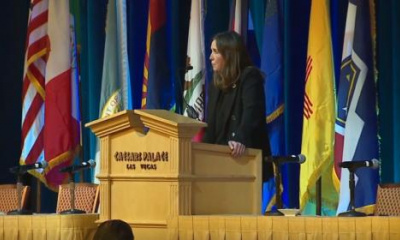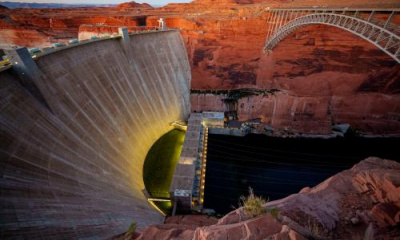Autumn Gillard's dark eyes are serious as she gazes upon the hordes of visitors on the Virgin River bank in Zion National Park. The striking red cliffs form a natural amphitheater carved by the river's sheer power at the Temple of Sinawava as she contemplates Native Americans' relationship to the water.
Gillard, the cultural resource manager of the Paiute Indian Tribe of Utah, told St. George News that the Colorado River and its tributaries, including the Virgin River in southwest Utah, are considered among Native Americans' most sacred pieces of ancestral landscape.
"It is a symbolization of the lifeblood of Mother Earth," Gillard said, adding that she believes the river should always be protected and treated with respect.
"I sit here alongside the river today and watch visitors interact with the river; I see a lot of people disturbing the river. There are people right now throwing rocks in the river, picking up stones, throwing them on the ground and not realizing that this river has a spirit. It has a voice and a power, and that true power lies in natural resources like rivers. We must always maintain them and try our best to keep them wild and free to roam as nature intended them to."
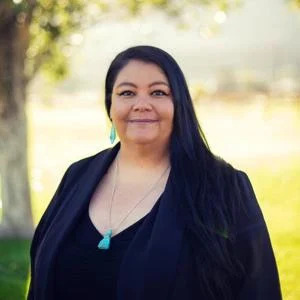
Autumn Gillard, the cultural resource manager of the Southern Paiute Tribe, says the Colorado River and its tributaries, including the Virgin River, are considered among Native Americans' most sacred pieces of ancestral landscape; photo location and date not specified. Photo courtesy of the Paiute Indian Tribe of Utah, St. George News
The Virgin River travels through Zion National Park southwest through Utah, Arizona and Nevada before connecting with the Colorado River, flowing along the ancestral homelands of the Southern Paiute people.
Gillard has firsthand knowledge of growing up and being raised by her grandmother and mother in a traditional home. She is a maternal descendant of the Cedar Band of Paiute Indians of Utah. Gillard is an expert in Southern Paiute astronomy, ethnobotany and culture. She graduated from Southern Utah University with a bachelor's degree in anthropology, minoring in psychology. She also earned a master's degree in cultural resource management from New Mexico Highlands University.
"In our culture, we view the landscape as one living piece all intertwined with one another, and in order to maintain a good stewardship of the landscape, we must treat all waterways from a holistic conservation mentality," Gillard said.
The quality of the rivers affects whether tribal members can continue their fishing tradition. Gillard said fishing in the Colorado River is a traditional skill her people have used to this day.
"Our tribal members still fish in the river and its tributaries. We monitor the resources along the river, including culture and the environment," Gillard said. "Ceremonial connections are private and kept within our communities. We do not view the river traditionally as an economic resource; money is not a part of our traditional interpretation of the river."
Gillard added that tribal members in Southern Utah recognize the river daily "as a source of life, power, and maternal energy." She said they are taught to interact with the river as a family member.
"If we care for the river, she will care for us," Gillard said.
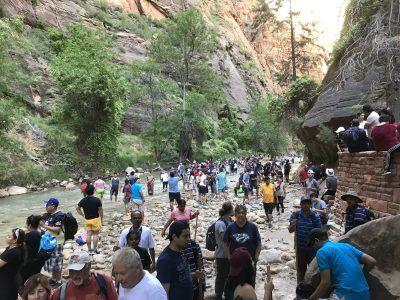
Crowds at the entrance to the Narrows, Zion National Park, Utah, date not specified. Photo courtesy of the National Park Service, St. George News
Among the Paiute tribe members who monitor the cultural and environmental quality of the Colorado River is Hope Silvas, chairman of the Shivwits Band of Paiutes.
The Paiute bands in Southern Utah partner with the Kaibab Paiute Tribe for a 10-day Colorado River trip in June every year, which includes adults and youth. The trips help educate the youth about their culture and their ties with that area and the river.
"It also gives the children a chance to bond with other youth from different areas," Silvas said. "So they can get to know each other, including the Moapa and Kaibab tribes."
Traditionally, the river was used for agricultural needs. Gillard said the Southern Paiutes used the three-sisters method of farming, which includes plants like corn, beans and squash. The other sisters are sunflowers, different types of chiles and varieties of plants to help with insect control.
According to the Shivwits Band website, ancestral people grew numerous crops and gathered 96 species of edible plants, which they used for food and medicinal purposes.
Another regional group of Native Americans dependent upon the Colorado River in a different way is the Hualapai Tribe. Their reservation comprises around 1 million acres along 108 miles of the Grand Canyon and Colorado River in northern Arizona. "Hualapai" means "People of the Tall Pines."

The Virgin River, a tributary of the Colorado River inside Zion National Park at the Temple of Sinawava, is sacred to Native Americans, Utah, date not specified. Photo by Stephanie DeGraw, St. George News
Hualapai Tribe member Siddell Smela, 28, recently shared his experience as a river runner with St. George News. He has been working for the Hualapai River Runners for eight years, on and off. The company is a Native American-owned and operated river rafting company based on the Colorado River's Diamond Creek to Pearce Ferry section.
"I always find myself coming back to this job because of the spectacular views of the Colorado River in the Grand Canyon. I like to share it. The canyon is alive with water and animals," Smela said.
His smile grew wide as he remembered the day's unusual appearance of a large bighorn desert sheep on the rocky cliff above his boat, which was full of tourists.
"We're fortunate enough to see a bighorn sheep today; that's a blessing," Smela said. "To see a bighorn sheep is a blessing upon us. So that was pretty cool to see."
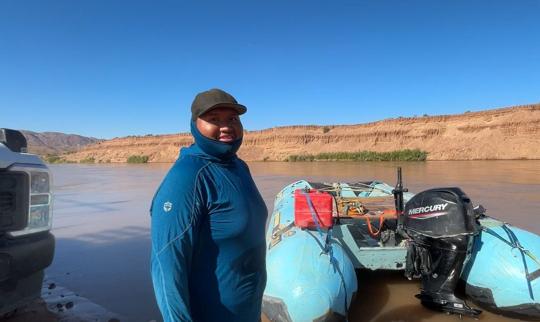
Siddell Smela, a river runner for the Hualapai River Runners on the Colorado River in the Grand Canyon, Peach Springs, Arizona, September 27, 2024. Photo by Stephanie DeGraw, St. George News
The river guide said his grandfather shared a life lesson that has stuck with him: "He told me that water is powerful; it can give life or take life. We couldn't survive off soda or energy drinks. We need water to live."
Smela added that while the Colorado River gives life, it can also take life because it's so powerful when whitewater rafting.
"You can easily drown or get hurt in that water," he said.
Smela said his job takes a physical toll on his body, but it's worth seeing the beauty and meeting new people worldwide every day.
Smela is one of a relative handful of people making up the Hualapai Tribe. According to the 2018-2022 U.S. Census, approximately 1,738 individuals live on the Hualapai Reservation in Arizona along the Colorado River and its surrounding landscapes. Tribal members use these lands to hunt, gather and hold ceremonies.
Ka-Voka Jackson, director/tribal historic preservation officer for the Hualapai Department of Cultural Resources, told St. George News the river contributes to many aspects of their cultural life.

A boat with tourists on the Colorado River in the Grand Canyon, Peach Springs, Arizona, September 27, 2024. Photo by Stephanie DeGraw, St. George News
Smela is one of a relative handful of people making up the Hualapai Tribe. According to the 2018-2022 U.S. Census, approximately 1,738 individuals live on the Hualapai Reservation in Arizona along the Colorado River and its surrounding landscapes. Tribal members use these lands to hunt, gather and hold ceremonies.
Ka-Voka Jackson, director/tribal historic preservation officer for the Hualapai Department of Cultural Resources, told St. George News the river contributes to many aspects of their cultural life.
"We consider the Colorado River the backbone of our people; it is central to our belief systems and our ways of life," Jackson said. "We have continued to use these lands for ceremony and survival, including hunting, gathering and going on river trips to connect with our spiritual places."
Jackson said the Hualapai Tribe is very active in the management of this land, including cultural and natural resources, in collaboration with other government agencies.
"As we live in a primarily desert environment, the river was a great source of life for our people," Jackson said, adding that the health of the systems connected to the river is important to keep everything in balance, including the plants, fish, animals and other living things that depend on the waters for survival.
"We also use the water in ceremonies, sometimes including consumption, so water quality is important for our health. We are very connected to the natural world around us. If those things are unhealthy, it affects our people emotionally, spiritually and even physically," Jackson said. "Good water quality is especially important for native fish, which we hold in high regard."
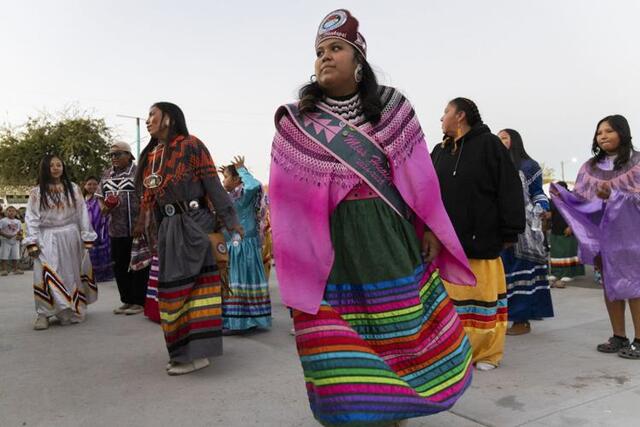
Hualapai Tribal members at a community celebration, Peach Springs, Arizona, September 26, 2024. Photo courtesy of J. Daniel Hud
"We have departments dedicated to monitoring the health of these aspects, including the Department of Natural Resources and the Department of Cultural Resources," Jackson said. "Everything upstream the Colorado River from our reservation eventually travels to us. Thus, we strive to be involved in the stewardship of the waters and environments upstream to ensure the good health of the overall system. As for tributaries, the Natural Resources Department conducts springs and tributaries surveys on reservation lands to monitor their health."
In addition to tourism, the Hualapai Tribe depends economically upon the Colorado River ecosystem for outdoor hunting and fishing. The tribe sells guided big-game hunting permits for desert bighorn sheep, trophy elk, antelope and mountain lion.



